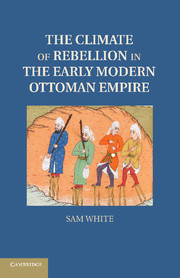Book contents
- Frontmatter
- Contents
- Acknowledgments
- Preface
- Glossary of Ottoman Terms
- Maps
- Introduction
- Part I An Imperial Ecology
- Part II The Little Ice Age Crisis
- 5 The Little Ice Age in the Near East
- 6 The Great Drought
- 7 The Celali Rebellion
- 8 In the Wake of the Celalis
- Part III Ecological Transformation
- Conclusion
- Bibliography
- Index
- References
7 - The Celali Rebellion
Published online by Cambridge University Press: 05 February 2012
- Frontmatter
- Contents
- Acknowledgments
- Preface
- Glossary of Ottoman Terms
- Maps
- Introduction
- Part I An Imperial Ecology
- Part II The Little Ice Age Crisis
- 5 The Little Ice Age in the Near East
- 6 The Great Drought
- 7 The Celali Rebellion
- 8 In the Wake of the Celalis
- Part III Ecological Transformation
- Conclusion
- Bibliography
- Index
- References
Summary
Even as the drought lifted in late 1596, conditions in the empire went from bad to worse. Bandit gangs grew larger and more brazen in their attacks, taking a mounting toll on provincial towns and villages. In time, these groups coalesced into rebel armies called Celalis, led by a motley succession of commanders. Meanwhile, wars in Hungary and then Persia along with a new rebellion in Syria left Ottoman forces incapable of handling the revolt. The violence unleashed a flood of refugees, driving a vicious cycle of desperation, lawlessness, and flight. Persistent Little Ice Age weather fueled the crisis, bringing famine even worse than that of the Great Drought. Only after peace with the Habsburgs in 1606 could the empire even begin to deal with the Celalis and bring a semblance of order to Anatolia. Even then the Ottomans had to pass through several more winters of extreme cold and privation, leaving parts of the empire depopulated for decades, even centuries to come.
- Type
- Chapter
- Information
- The Climate of Rebellion in the Early Modern Ottoman Empire , pp. 163 - 186Publisher: Cambridge University PressPrint publication year: 2011

